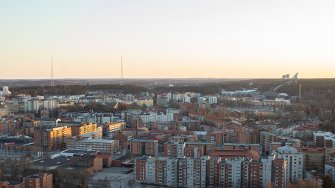Everything affects everything else – Well-being is more than just physical health

Well-being is now ubiquitous. It is discussed and written about and, above all, efforts are made to support it, both by relying on professionals and in individuals’ lives. This has not always been the case, however.
“People only started talking about well-being as a concept in the 2010s. Before this, the main focus was on health," says Emilia Laapio-Rapi, Principal Lecturer at LAB.
The health perspective has curtailed the discussion on human well-being. In particular, the topic has been approached from the perspective of physical well-being. In today's discussions the human being is seen holistically, while well-being is a concept that covers not only physical and psychological well-being but also economic security and environmental impacts, for instance.
“This diversification provides a better basis for measuring and examining the realisation of well-being. On the other hand, it also challenges perceptions of well-being,” says Jaana Valtonen, expert in social welfare and health care management and development at LAB.
There is a dawning understanding of how an individual's well-being depends on many different elements. Everything affects everything else.
This breakthrough in thinking has not been purely conceptual. The individual's personal agency regarding their well-being has also changed. Rather than only being the professionals' responsibility, well-being is now something that the individual can actively influence.
“This transformation has also been influenced by service structures. We have traditionally discussed social welfare and health care separately. Different parties have also been responsible for organising these services. While they have now been combined, the old silos have not yet been completely eliminated,” says Laapio-Rapi.
Transition from industry to services has altered well-being at work
The transformation of well-being has also given more prominence to its shortcomings. For example, the debate on well-being at work and burnout has positively exploded.
The factors affecting this include the transformation of not only well-being but also the entire world of work. Finland has evolved from an industrial society to a service society, which has also changed the nature of the working life. Physical strain has been replaced by psychological stress, and the pace is ever faster.
“As work is not physical, more attention must be paid to people’s physical activity, whereas employers’ attitudes towards well-being at work have also changed. It has been noticed that a labour force with a high level of well-being translates as better employees for the organisation," says Laapio-Rapi.
Well-being at work is becoming a competitive advantage for employers.
In addition to well-being at work, a broader discussion about the challenges of coping and mental health encountered by people of different ages is highly topical.
“Especially for young people, influencing this by supporting their experiences of self-efficacy would be important,” Valtonen says.
Just talking about not having enough money affects well-being
Another topic that has sparked a great deal of discussion recently is the health and social services system together with its resources and funding. The clinical quality of Finnish health care remains high. While in global level we have a high vaccination coverage and low post-natal mortality rate, accessing services has become more difficult.
"The system appears to be broken because the resources for organising the services are not sufficient. Finland’s demographic trends require a fair reorganisation of the structures, but reforms have currently remained small, and public discussion is taking on an increasingly negative tone. This has had a direct impact on people’s experiences of well-being, as they are concerned over whether or not they can access the services they need.”
Laapio-Rapi stresses that individuals naturally also have a personal responsibility for their well-being and taking care of it. This does not eliminate the need for services, however.
“An individual can manage a wide range of things without expert help. The importance of this is increasing from the viewpoint of the unavoidable change in the service structure.”
Valtonen also brings up the significance of communality in enabling and increasing well-being.
“Considering the resource-related challenges in the social welfare and health care sector, for example, a sense of community would be needed to support older people's well-being.”

Well-being risks to become a luxury product
The transformation has consequently led to an understanding of the holistic nature of well-being, while the scarcity of resources has brought up a challenge that has not yet been solved. Well-being risks to become a luxury product. The gap between groups of people is already visible today.
"Those who are thriving have a better level of well-being than ever. For those in a less favourable position, the increase in well-being has not been as strong”, says Jaana Valtonen.
Technology could be part of the solution. Laapio-Rapi stresses that technology cannot replace people in services. When talking about well-being, human encounters play an important role.
Used appropriately, however, technology could ease the workload of people working in services in so-called 'dumb jobs'. This would leave them with more resources for human encounters and could also reduce the costs of organising services.
Valtonen also points out that technology can support an individual's self-motivated efforts to improve their personal well-being, enabling them to measure and promote it.
On the other hand, the line between opportunity and threat is vague in this case. The impact of smart devices on people is not straightforward. It has been claimed that screen time has a negative impact on people’s ability to concentrate, physical activity and social relationships alike.
All of these factors in turn have an impact on the fundamental issue, which is the individual's holistic well-being.


